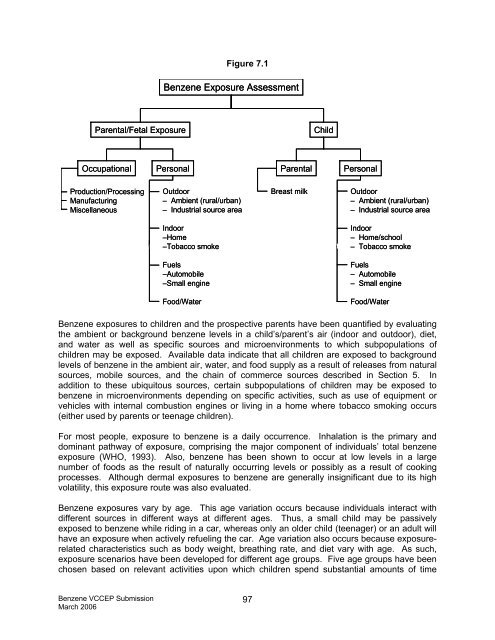(VCCEP) Tier 1 Pilot Submission for BENZENE - Tera
(VCCEP) Tier 1 Pilot Submission for BENZENE - Tera
(VCCEP) Tier 1 Pilot Submission for BENZENE - Tera
Create successful ePaper yourself
Turn your PDF publications into a flip-book with our unique Google optimized e-Paper software.
Parental/Fetal Exposure<br />
Occupational<br />
Production/Processing<br />
Manufacturing<br />
Miscellaneous<br />
Benzene <strong>VCCEP</strong> <strong>Submission</strong><br />
March 2006<br />
Figure 7.1<br />
Benzene Exposure Assessment<br />
Personal<br />
Outdoor<br />
– Ambient (rural/urban)<br />
– Industrial source area<br />
Indoor<br />
–Home<br />
–Tobacco smoke<br />
Fuels<br />
–Automobile<br />
–Small engine<br />
Food/Water<br />
97<br />
Parental<br />
Child<br />
Personal<br />
Breast milk Outdoor<br />
– Ambient (rural/urban)<br />
– Industrial source area<br />
Indoor<br />
– Home/school<br />
– Tobacco smoke<br />
Fuels<br />
– Automobile<br />
– Small engine<br />
Food/Water<br />
Benzene exposures to children and the prospective parents have been quantified by evaluating<br />
the ambient or background benzene levels in a child’s/parent’s air (indoor and outdoor), diet,<br />
and water as well as specific sources and microenvironments to which subpopulations of<br />
children may be exposed. Available data indicate that all children are exposed to background<br />
levels of benzene in the ambient air, water, and food supply as a result of releases from natural<br />
sources, mobile sources, and the chain of commerce sources described in Section 5. In<br />
addition to these ubiquitous sources, certain subpopulations of children may be exposed to<br />
benzene in microenvironments depending on specific activities, such as use of equipment or<br />
vehicles with internal combustion engines or living in a home where tobacco smoking occurs<br />
(either used by parents or teenage children).<br />
For most people, exposure to benzene is a daily occurrence. Inhalation is the primary and<br />
dominant pathway of exposure, comprising the major component of individuals’ total benzene<br />
exposure (WHO, 1993). Also, benzene has been shown to occur at low levels in a large<br />
number of foods as the result of naturally occurring levels or possibly as a result of cooking<br />
processes. Although dermal exposures to benzene are generally insignificant due to its high<br />
volatility, this exposure route was also evaluated.<br />
Benzene exposures vary by age. This age variation occurs because individuals interact with<br />
different sources in different ways at different ages. Thus, a small child may be passively<br />
exposed to benzene while riding in a car, whereas only an older child (teenager) or an adult will<br />
have an exposure when actively refueling the car. Age variation also occurs because exposure-<br />
related characteristics such as body weight, breathing rate, and diet vary with age. As such,<br />
exposure scenarios have been developed <strong>for</strong> different age groups. Five age groups have been<br />
chosen based on relevant activities upon which children spend substantial amounts of time





